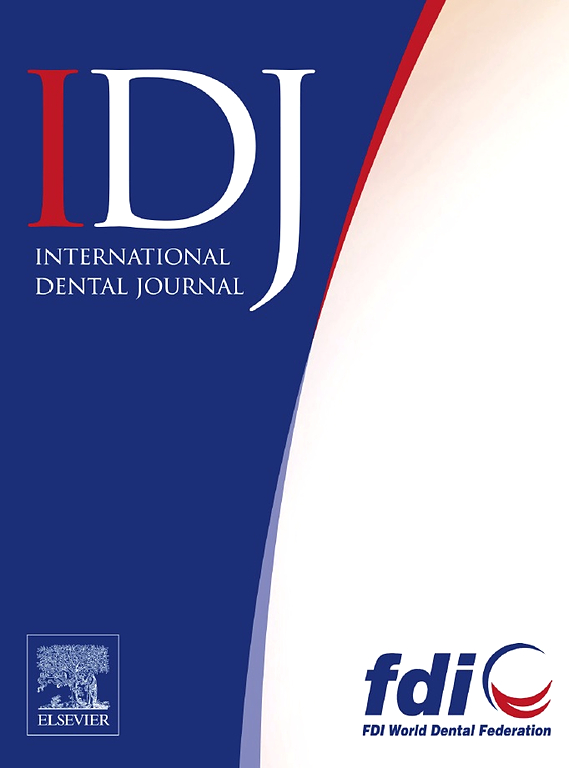基于超声显微镜的牙釉质和修复材料鉴定:体外声阻抗研究
IF 3.7
3区 医学
Q1 DENTISTRY, ORAL SURGERY & MEDICINE
引用次数: 0
摘要
介绍和目的在牙科检查中区分修复材料和牙釉质是具有挑战性的,因为它们的外观相似。即使使用超声显微镜,修复材料的声学特性仍未得到评估。本研究探讨了超声显微镜鉴别牙釉质、复合树脂和玻璃离子的潜力。方法拔出第三磨牙作为牙模型:在牙釉质上钻一个直径1.2 mm的圆柱形腔,用复合树脂(可流动填充或膏体)或玻璃离子水门合剂(常规、高填料或多离子)修复。为了评估修复材料,我们将直径2.0 mm,深度3.0 mm的空腔铣削成PMMA块并填充相同的材料来制备第二个模型。在超声显微镜下对两种模型进行成像以获得声阻抗图,然后对PMMA样品进行维氏硬度测试以探索硬度与声阻抗之间的相关性。结果在4.8 mm × 4.8 mm的范围内,声阻抗测量精度为16 μ m × 16 μ m /像素,可以构建有效区分牙釉质和修复材料的二维彩色图像。CR的颜色分布是均匀的,而GIC在所有样本中表现出异质性分布。牙釉质的平均声阻抗(15.6±4.37 kg/m²s)明显大于CR(5.36±0.264 kg/m²s, 5.49±0.323 kg/m²s)和GIC(高填料型4.80±0.360 kg/m²s,多离子型3.80±0.360 kg/m²s,常规型3.74±0.353 kg/m²s) (P <;. 01)。根据组合标准差(σ 1 + σ 2)建立不同的阈值。两两比较证实了牙釉质、CR和GIC的区别。结论超声显微镜可有效区分牙釉质和修复体材料,并可通过声阻抗测量区分修复体材料(CR和GIC)。这些发现表明,超声显微镜可以帮助识别修复边缘和评估材料在临床设置。本文章由计算机程序翻译,如有差异,请以英文原文为准。
Ultrasound Microscopy-Based Identification of Enamel and Restorative Materials: An Ex Vivo Acoustic Impedance Study
Introduction and aims
Differentiating restorative materials from enamel during dental examinations is challenging because of their similar appearances. Even with ultrasound microscopy, the acoustic properties of restorative materials remain unassessed. This study investigated the potential of ultrasound microscopy to differentiate between enamel, composite resin, and glass ionomer.
Methods
Extracted third molars served as the tooth model: a 1.2 mm-diameter cylindrical cavity drilled into the enamel and restored with either composite resin (flowable bulk-fill or paste) or glass-ionomer cement (conventional, high-filler, or multi-ion). To evaluate the restorative materials, a second model was prepared by milling a 2.0 mm-diameter, 3.0 mm-deep cavity into a PMMA block and filling it with the same materials. Both models were imaged with ultrasound microscopy to obtain acoustic-impedance maps, and the PMMA specimens subsequently underwent Vickers hardness testing to explore the correlation between hardness and acoustic impedance.
Results
Acoustic impedance was measured with an accuracy of 16 µm × 16 µm per pixel over an area of 4.8 mm × 4.8 mm, allowing for the construction of 2-dimensional colour images that effectively differentiated between enamel and restorative materials. The colour distribution for CR was homogeneous, while GIC exhibited a heterogeneous distribution across all samples. The mean acoustic impedance of enamel (15.6 ± 4.37 kg/m²s) was significantly greater than that of CR (Type Flow 5.36 ± 0.264 kg/m²s, Type Paste 5.49 ± 0.323 kg/m²s) and GIC (Type high-filler 4.80 ± 0.360 kg/m²s, Multiple ion 3.80 ± 0.360 kg/m²s, Conventional 3.74 ± 0.353 kg/m²s) (P < .01). A distinct threshold was established based on the combined standard deviations (σ₁ + σ₂). Pairwise comparisons confirming the distinguishability of enamel, CR, and GIC.
Conclusion
Ultrasound microscopy effectively distinguishes between enamel and restorative materials, as well as between restorative materials (CR and GIC) through acoustic impedance measurement.
Clinical relevance
These findings suggest that ultrasound microscopy may assist in identifying restoration margins and assessing materials in clinical settings.
求助全文
通过发布文献求助,成功后即可免费获取论文全文。
去求助
来源期刊

International dental journal
医学-牙科与口腔外科
CiteScore
4.80
自引率
6.10%
发文量
159
审稿时长
63 days
期刊介绍:
The International Dental Journal features peer-reviewed, scientific articles relevant to international oral health issues, as well as practical, informative articles aimed at clinicians.
 求助内容:
求助内容: 应助结果提醒方式:
应助结果提醒方式:


